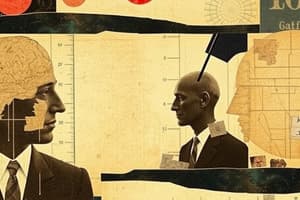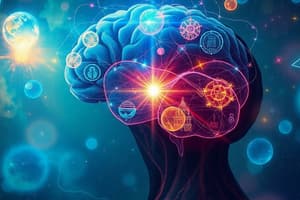Podcast
Questions and Answers
What is an example of spatial intelligence?
What is an example of spatial intelligence?
The ability to perceive and transform visual information, evident in artists.
How does intrapersonal intelligence differ from interpersonal intelligence?
How does intrapersonal intelligence differ from interpersonal intelligence?
Intrapersonal intelligence is the understanding of one's own feelings, while interpersonal intelligence is the sensitivity to others' motivations and moods.
What are the three aspects of intelligent behavior in Sternberg's Triarchic Theory?
What are the three aspects of intelligent behavior in Sternberg's Triarchic Theory?
Components, Context, and Experience.
How do Gardner's multiple intelligences theory and Sternberg's theory complement each other?
How do Gardner's multiple intelligences theory and Sternberg's theory complement each other?
What does the term 'street smarts' refer to in the context of Sternberg's Triarchic Theory?
What does the term 'street smarts' refer to in the context of Sternberg's Triarchic Theory?
What does Howard Gardner's theory propose about human intelligence?
What does Howard Gardner's theory propose about human intelligence?
How does the criterion of 'Isolation as a Brain Function' contribute to identifying an intelligence?
How does the criterion of 'Isolation as a Brain Function' contribute to identifying an intelligence?
Why are prodigies and savants significant in Gardner's theory?
Why are prodigies and savants significant in Gardner's theory?
What role does developmental history play in Gardner's criteria for an intelligence?
What role does developmental history play in Gardner's criteria for an intelligence?
What caution should be taken regarding IQ scores according to the content?
What caution should be taken regarding IQ scores according to the content?
What role do psychometric instruments play in measuring intelligence?
What role do psychometric instruments play in measuring intelligence?
What is one key characteristic of intelligence according to contemporary definitions?
What is one key characteristic of intelligence according to contemporary definitions?
Name two features that characterize true intelligence as per the content provided.
Name two features that characterize true intelligence as per the content provided.
How has the perception of intelligence changed from early definitions?
How has the perception of intelligence changed from early definitions?
List three of the eight multiple intelligences mentioned.
List three of the eight multiple intelligences mentioned.
What does the term 'adaptive thinking' in intelligence primarily refer to?
What does the term 'adaptive thinking' in intelligence primarily refer to?
What is the significance of the Multiple Intelligence theory in relation to psychometric testing?
What is the significance of the Multiple Intelligence theory in relation to psychometric testing?
How does cultural anthropology relate to the development of human intelligence?
How does cultural anthropology relate to the development of human intelligence?
Why is understanding the variability of intelligence important?
Why is understanding the variability of intelligence important?
What does the study of intelligence often utilize to measure cognitive ability?
What does the study of intelligence often utilize to measure cognitive ability?
What does Charles Spearman's two-factor theory of intelligence consist of?
What does Charles Spearman's two-factor theory of intelligence consist of?
List three of the primary mental abilities identified by Louis Thurstone.
List three of the primary mental abilities identified by Louis Thurstone.
How do fluid intelligence and crystallized intelligence differ?
How do fluid intelligence and crystallized intelligence differ?
What is the significance of the g factor in Spearman's theory?
What is the significance of the g factor in Spearman's theory?
According to Thurstone, which primary mental ability is related to the quick noting of visual detail?
According to Thurstone, which primary mental ability is related to the quick noting of visual detail?
What is the key teaching strategy for helping concrete operational thinkers understand mathematical operations?
What is the key teaching strategy for helping concrete operational thinkers understand mathematical operations?
How can teachers support formal operational thinkers in developing problem-solving skills?
How can teachers support formal operational thinkers in developing problem-solving skills?
What does a constructivist approach emphasize in children's learning according to Piaget's theory?
What does a constructivist approach emphasize in children's learning according to Piaget's theory?
What is one way to assess children's understanding according to the principles of Piaget's theory?
What is one way to assess children's understanding according to the principles of Piaget's theory?
What strategy should be used to help children understand conservation concepts?
What strategy should be used to help children understand conservation concepts?
How can promoting intellectual health be aligned with Piaget's educational strategies?
How can promoting intellectual health be aligned with Piaget's educational strategies?
What is an effective group activity for concrete operational thinkers?
What is an effective group activity for concrete operational thinkers?
What should teachers do to help formal operational thinkers structure their writing?
What should teachers do to help formal operational thinkers structure their writing?
What principle underlies many educational programs based on Piaget's theory?
What principle underlies many educational programs based on Piaget's theory?
What is the zone of proximal development (ZPD) according to Vygotsky?
What is the zone of proximal development (ZPD) according to Vygotsky?
How can teachers utilize the concept of ZPD in their teaching methods?
How can teachers utilize the concept of ZPD in their teaching methods?
What role does a supportive learning environment play in a child's development?
What role does a supportive learning environment play in a child's development?
What is one instructional strategy derived from Piaget's work?
What is one instructional strategy derived from Piaget's work?
What factors can lead to fluctuations in a child's IQ scores over time?
What factors can lead to fluctuations in a child's IQ scores over time?
How does creativity relate to intelligence in early childhood?
How does creativity relate to intelligence in early childhood?
What is myelination, and why is it significant in early childhood?
What is myelination, and why is it significant in early childhood?
What does reciprocal teaching involve in the classroom?
What does reciprocal teaching involve in the classroom?
How can social interactions help reduce egocentrism in preoperational thinkers?
How can social interactions help reduce egocentrism in preoperational thinkers?
What teaching strategy involves having children manipulate groups of objects?
What teaching strategy involves having children manipulate groups of objects?
Describe how comparing objects can aid cognitive development in children.
Describe how comparing objects can aid cognitive development in children.
What is the purpose of constructing an inclined plane for children in learning about speed?
What is the purpose of constructing an inclined plane for children in learning about speed?
What is emphasized in the At Standard 10 evaluation for Needs, Goals, and Objectives?
What is emphasized in the At Standard 10 evaluation for Needs, Goals, and Objectives?
How does the Approaching Standard 5 differ from At Standard 10?
How does the Approaching Standard 5 differ from At Standard 10?
What main characteristic defines evaluation under Below Standard 1?
What main characteristic defines evaluation under Below Standard 1?
What does a comprehensive Project Implementation Plan require according to the At Standard 10?
What does a comprehensive Project Implementation Plan require according to the At Standard 10?
In Approaching Standard 5, what are the characteristics of the Project Implementation Plan?
In Approaching Standard 5, what are the characteristics of the Project Implementation Plan?
What critical issue is identified in the evaluation for At Standard 10 under Evaluation, Potential Risk, Sustainability?
What critical issue is identified in the evaluation for At Standard 10 under Evaluation, Potential Risk, Sustainability?
How does the evaluation differ at Below Standard 1 regarding the identification of issues?
How does the evaluation differ at Below Standard 1 regarding the identification of issues?
What does a presentation need to achieve to meet the criteria of At Standard 10?
What does a presentation need to achieve to meet the criteria of At Standard 10?
What type of processes are outlined in the evaluation for Below Standard 1 under Needs, Goals, and Objectives?
What type of processes are outlined in the evaluation for Below Standard 1 under Needs, Goals, and Objectives?
What is a common attribute found in the evaluation components across all standards?
What is a common attribute found in the evaluation components across all standards?
Flashcards
Spatial Intelligence
Spatial Intelligence
The ability to perceive and transform visual information, like an artist.
Bodily-Kinesthetic Intelligence
Bodily-Kinesthetic Intelligence
Physical intelligence; the ability to use body effectively, e.g., dancers, athletes.
Interpersonal Intelligence
Interpersonal Intelligence
Understanding others' feelings and motivations
Intrapersonal Intelligence
Intrapersonal Intelligence
Signup and view all the flashcards
Triarchic Theory of Intelligence
Triarchic Theory of Intelligence
Signup and view all the flashcards
Multiple Intelligences
Multiple Intelligences
Signup and view all the flashcards
Linguistic Intelligence
Linguistic Intelligence
Signup and view all the flashcards
Logical-Mathematical Intelligence
Logical-Mathematical Intelligence
Signup and view all the flashcards
Musical Intelligence
Musical Intelligence
Signup and view all the flashcards
Visual-Spatial Intelligence
Visual-Spatial Intelligence
Signup and view all the flashcards
g factor
g factor
Signup and view all the flashcards
Primary Mental Abilities
Primary Mental Abilities
Signup and view all the flashcards
Fluid Intelligence
Fluid Intelligence
Signup and view all the flashcards
Crystallized Intelligence
Crystallized Intelligence
Signup and view all the flashcards
Psychometric Approach
Psychometric Approach
Signup and view all the flashcards
Eight Criteria for Intelligence
Eight Criteria for Intelligence
Signup and view all the flashcards
Brain Localization
Brain Localization
Signup and view all the flashcards
Prodigies and Savants
Prodigies and Savants
Signup and view all the flashcards
Core Operations
Core Operations
Signup and view all the flashcards
Developmental History
Developmental History
Signup and view all the flashcards
Intelligence
Intelligence
Signup and view all the flashcards
General Mental Ability (G)
General Mental Ability (G)
Signup and view all the flashcards
Intelligence and Evolution
Intelligence and Evolution
Signup and view all the flashcards
Adaptive Thinking
Adaptive Thinking
Signup and view all the flashcards
Intelligence and Learning
Intelligence and Learning
Signup and view all the flashcards
Concrete Operational Thinkers
Concrete Operational Thinkers
Signup and view all the flashcards
Facilitating Learning
Facilitating Learning
Signup and view all the flashcards
Constructivist Approach
Constructivist Approach
Signup and view all the flashcards
Formal Operational Thinkers
Formal Operational Thinkers
Signup and view all the flashcards
Ongoing Assessment
Ongoing Assessment
Signup and view all the flashcards
Myelination
Myelination
Signup and view all the flashcards
Encourage Exploration & Discovery
Encourage Exploration & Discovery
Signup and view all the flashcards
Conservation of Properties
Conservation of Properties
Signup and view all the flashcards
Preoperational Thinkers
Preoperational Thinkers
Signup and view all the flashcards
Egocentrism
Egocentrism
Signup and view all the flashcards
Ascending and Descending Classification
Ascending and Descending Classification
Signup and view all the flashcards
How do manipulation of objects help preoperational thinkers?
How do manipulation of objects help preoperational thinkers?
Signup and view all the flashcards
Why are social interactions important for preoperational thinkers?
Why are social interactions important for preoperational thinkers?
Signup and view all the flashcards
Piaget's Impact on Education
Piaget's Impact on Education
Signup and view all the flashcards
Vygotsky's Impact on Education
Vygotsky's Impact on Education
Signup and view all the flashcards
Zone of Proximal Development (ZPD)
Zone of Proximal Development (ZPD)
Signup and view all the flashcards
Reciprocal Teaching
Reciprocal Teaching
Signup and view all the flashcards
IQ Scores in Childhood
IQ Scores in Childhood
Signup and view all the flashcards
Supportive Learning Environment
Supportive Learning Environment
Signup and view all the flashcards
Intelligence and Creativity
Intelligence and Creativity
Signup and view all the flashcards
Creativity Throughout Early Childhood
Creativity Throughout Early Childhood
Signup and view all the flashcards
What is the "At Standard 10" evaluation criteria?
What is the "At Standard 10" evaluation criteria?
Signup and view all the flashcards
What is the "Approaching Standard 5" evaluation criteria?
What is the "Approaching Standard 5" evaluation criteria?
Signup and view all the flashcards
What is the "Below Standard 1" evaluation criteria?
What is the "Below Standard 1" evaluation criteria?
Signup and view all the flashcards
Needs, Goals, and Objectives, Theory Use
Needs, Goals, and Objectives, Theory Use
Signup and view all the flashcards
Project Implementation Plan
Project Implementation Plan
Signup and view all the flashcards
Evaluation, Potential Risk, Sustainability
Evaluation, Potential Risk, Sustainability
Signup and view all the flashcards
What are the three standards used to evaluate a project?
What are the three standards used to evaluate a project?
Signup and view all the flashcards
How is "At Standard 10" different from "Approaching Standard 5"?
How is "At Standard 10" different from "Approaching Standard 5"?
Signup and view all the flashcards
What is the importance of theory in project evaluation?
What is the importance of theory in project evaluation?
Signup and view all the flashcards
How do evaluation standards relate to project performance?
How do evaluation standards relate to project performance?
Signup and view all the flashcards
Study Notes
Evolutionary History
- Cultural anthropologists study how human intelligence developed through experience.
Supported Psychological Tasks
- Clinical psychologists identify tasks for different human behaviors to assess intelligence.
- Intelligence can be identified by specific tasks.
Supported Psychometric Tasks
- Psychometric instruments (like IQ tests) traditionally measure specific types of ability.
- Multiple intelligence tests aim to measure unique intelligences scientifically.
Encoded Into a Symbol System
- Humans have developed symbol systems over time.
- Each intelligence has its own set of images unique to itself used to complete tasks.
Studying That Suits You
Use AI to generate personalized quizzes and flashcards to suit your learning preferences.




